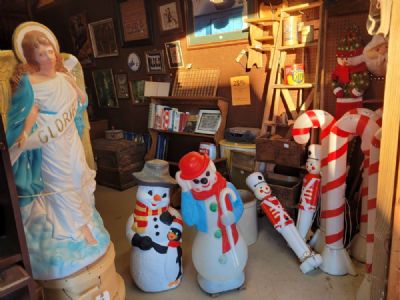Blow Molds
Who can forget Clark Griswold trying to decorate his house for Christmas with a plastic Santa and
reindeer? Those ever-popular plastic lawn decorations are called “blow molds”, which is a
manufacturing process where melted plastic is blown into a mold to form a hollow decorative piece. The
molds were typically made of aluminum which has better thermal conductivity than steel and could be
used repeatedly. Lawn art made of heavy bronze and imported from Europe was very popular in the
early 1900’s and was a luxury that only the wealthy could afford. By the late 1940’s, affordable plastic
lawn art was being produced and sold allowing everyone to be able to decorate their yards. The popular
sculptures had a light bulb inserted into the back that allowed the sculpture to glow. The most popular
blow mold company in history was “Union Products” which opened in 1946 in Leominster,
Massachusetts. Union was doing very well selling a variety of blow mold products and went on to hire a
recent art school graduate named Don Featherstone in 1957. This decision to hire Don would prove to
be a very profitable decision, as he designed over 750 of the 1000 designs that Union products produced
until it closed in 2006. Don’s most popular design was the pink flamingo, which earned him the Nobel
art prize in 1996. Don must have loved that flamingo, because he displayed 57 of them in his back yard!
Blow molds are highly collectible, especially pieces that have Don Featherstone imprinted on the
bottom. Condition of the piece along with rare designs can inflate the value. The nostalgic charm of
vintage blow molds brings back a lot of memories from childhood for many people, so it is not surprising
that manufacturers are once again producing blow mold yard art. Vintage (more than 30 years old)
blow molds will usually have signs of wear, the bottoms will be dirty and have scratches on them, and
the coloring will be sun-bleached or worn off. Some pieces used colored plastic like pumpkins, while
others were painted multiple colors after being un-molded. Check for a date on the bottom as many
older pieces are dated, while the newer pieces often have a made in China sticker or imprinted. When
caring for vintage blow molds, do not store them in a hot place like the attic as they will melt, and store
them upright to not dent or push in the molded design. Be sure to wipe them gently when cleaning with
a soft damp towel being careful to not remove the old paint. When displaying the lightweight plastic
pieces, weigh them down or they could blow away. A new light bulb kit can be easily purchased to
replace a worn out, broken, or missing light. Vintage blow molds were used to create more than just
holiday lawn decorations, such as watering cans, pumpkin trick-or-treat buckets, shampoo bottles,
coolers, fuel cans, etc. While the Christmas Candle, Santa, Snowman, and Nativity scene blow molds are
the most popular, always keep your eye out for rarer pieces when going to antique stores or flea
markets. For example, Dracula is a highly sought-after piece that is currently selling for over $200 on E-
bay! Be sure to stop by and check out the many blow molds for sale at Simply Vintage Marketplace in
Mason, MI.

